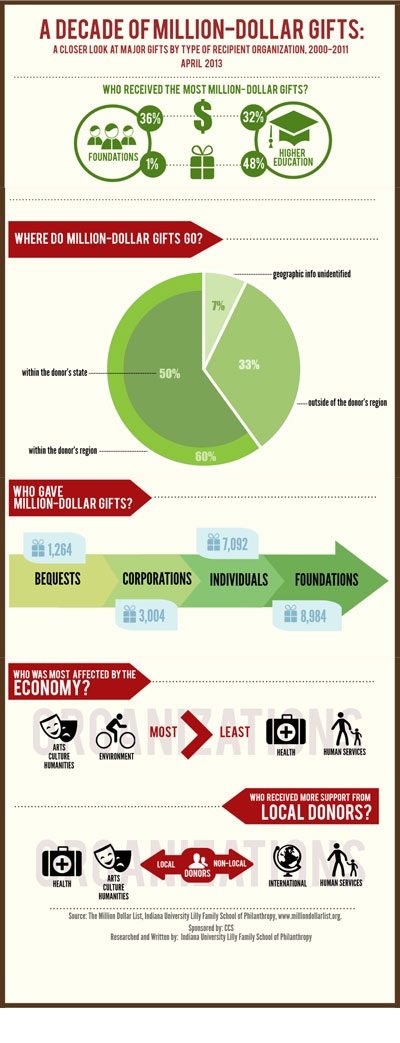
This report by the Lilly Family School of Philanthropy at IUPUI, the same folk who bring us Giving USA, looks at the patterns of million dollar gifts for the 12 year period between 2000 and 2011. Predictably, the years following both recessions make a very poor showing but there are some interesting though perhaps not revelatory facts here. One caveat is that this study includes only announced domestic gifts.
The findings here are quirky – affected as they are by extraordinarily large gifts made in some years.

Sign up for our free newsletters
Subscribe to NPQ's newsletters to have our top stories delivered directly to your inbox.
By signing up, you agree to our privacy policy and terms of use, and to receive messages from NPQ and our partners.
The big headline in this study was that mast million dollar gifts are made locally and this is true except where it pertains to Human Services and (wait for it) gifts made internationally but it may be that the MDGs from individuals are, in fact, as local as any other realm because human services gets a very small proportion of its million dollar gifts from individuals. In contrast to the whole field where individuals accounted for 40% of all MDGs and 65% of the dollar amount human services gets only 13% of its MDGs from individuals and 8% of the dollar amount. Other fields show very differently obviously with higher education receiving 48% of its million dollar gifts from individuals comprising 51% of the value of such gifts overall, or arts which gets 35% of its MDGs from individuals and 59% of the value of the total dollar amount. . Most of the MDGs for human services come from foundations and corporations. The number of MDGs to human services were weirdly high in 2005 when there were 354 gifts as compared to the mere 74 made in 2004 when the highest dollar amount ($2.1 billion) by far was logged due to one $1.7 billion gift. Since 2006 the number of gifts logged per year have ranged between 102 and 165. What was up in 2005?
But back to the headline many of you will have seen regarding the localness of gifts, five categories of recipient got more than 50% of their MDGs locally (health, arts and culture, foundations, higher education institutions, and government agencies) and, overall, roughly half of all million dollar donors came from the same state as the recipient organization and around 60% from the same region.
Foundations were the highest dollar recipient of MDGs over the 12 years studied, weighing in at a hefty $97 billion and this does not even include all of the money flowing into donor advised funds some of which is counted in the category of Public Benefit Organizations. Coming in in 2nd place higher education received $86 billion in MDG’s as contrasted to the $9 billion to human services. Even the arts only took in $15 billion and religious organizations took in a measly $1 billion.
The report’s authors comment that million dollar donations to the arts, culture and humanities seemed to be particularly sensitive to the economic climate. By 2010 the number of MDGs to the arts (100) had declined to half of what they were (200) in 2008 and the picture remains fairly depressed as of 2011 (123) although the dollar amounts had rebounded. Neither the dollar amount nor the number of MDGs to religious organizations had rebounded from the last recession as of 2011. The number of MDGs declined from a high of 26 in 2007 to 9 in 2010 and 12 in 2011. The dollar amounts were at their high of $283 million in 2006 but in the last two years (2010 and 2011) they have declined to $39 million.
Health organizations received a high of $2.7 billion in 2007. The number of gifts did not decline as quickly as they did for other types of organizations but the dollar amount did and in 2011 it was still half of what it was in 2007 although close to equal to what it was in 2008.
This report is interesting although we want to take the time to look at it against giving in general. We would love your observations.– Ruth McCambridge











